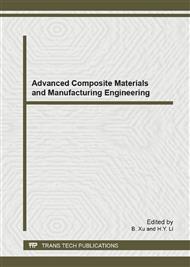p.171
p.175
p.179
p.183
p.187
p.191
p.195
p.199
p.203
Study on Composite Optics Properties of FeCl2·4H2O Crystal in Material Engineering
Abstract:
Crystal material has an important role in material engineering. FeCl2•4H2O crystal has broad prospects in composite which has been used in energy filed, water treatment field and chemstry industry. To investigate the relationship between properties and construction, absorption spectra has been researched.Considering the crystal structure parameters and average covalent factor N, the energy levels of Fe2+ in FeCl2•4H2O crystal are calculated by diagonalizing the energy matrix of d6. When the value of N is 0.9, the calculated results are in good agreement with the results of experiment. By investigating absorption spectra, the peaks at 5600 cm-1can be assigned as the splitting from1A1 to 5T2. The peak belongs to spin-forbidden transition. The peaks at 6300 cm-1 and 6600 cm-1 can be assigned as the splitting from 3T1 to 5T2 and 5E to 5T2 respectively, which belong to spin-forbidden transition and spin-allowed transition .The peak at 9100 cm-1can be assigned as the splitting from 3T2 to 5T2. The peak at 14800 cm-1 can be assigned as the splitting from 3T1 to 5T2. All results can be used for the production of optical devices.
Info:
Periodical:
Pages:
187-190
Citation:
Online since:
October 2012
Keywords:
Price:
Сopyright:
© 2012 Trans Tech Publications Ltd. All Rights Reserved
Share:
Citation:


